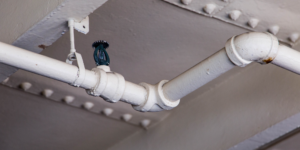Fire sprinklers are crucial to structure fire safety. They fight fires swiftly and prevent their spread, saving lives and property. Ever wondered why these sprinklers work so well? Important factors include the K-Factor.
The Fire Sprinkler K-Factor ensures that sprinkler water can control or reduce fires. Maintaining optimal fire protection requires understanding K-Factors and choosing the right one.
We will explain Fire Sprinkler K-Factors, their types, and how to choose one.
What is a Fire Sprinkler K-Factor?
The Fire Sprinkler K-Factor measures water distribution efficiency. It shows pressure-flow rate relationships at a given nozzle orifice size.
varying buildings need varying water flow for fire safety. The K-Factor delivers the right amount of water to fight fires based on hazard classification, occupancy type, and design requirements.
The sprinkler discharge coefficient depends on the K-Factor. This coefficient shows how much water the sprinkler will discharge per unit time at a certain pressure.
Larger orifices and higher flows are indicated by higher K-Factors. To suppress fires efficiently without wasting resources, choose the right K-Factor for your building.
Examine the marks on each sprinkler head in your building to get your Fire Sprinkler K-Factor. Manufacturer, temperature rating, response type, and most crucially, K-Factor are usually marked.
Several criteria must be evaluated to establish the best K-Factor for fire safety in your structure. Hazard categories (light or exceptionally high), occupancy type (residential versus commercial), ceiling height, storage layouts, and local code requirements or regulations are examples.
You can choose the best Fire Sprinkler K-factor by considering these factors and consulting with fire protection engineering or consulting experts who understand local fire safety codes.

The Different Types of Fire Sprinkler K-Factors
Fire sprinkler K-factors must be understood. The K-factor regulates how much water a sprinkler will spray on a fire. Multiple K-factors are employed in fire sprinkler systems.
The “standard response” or “fast response” sprinkler has a K-factor of 2.8 to 5.6. These are employed in residential buildings and high-hazard locations for speedy activation and suppression.
Alternatively, “commercial” or “residential” sprinklers have K-factors of 7.0 to 11.2. Commercial locations like warehouses and factories use these sprinklers to distribute more water.
There are also applications that require sprinklers with customized K-factors. Dry pipe, deluge, and pre-action systems have varying fire-control requirements depending on their environment.
The type of fire sprinkler system you need depends on building occupancy, hazard categorization, ceiling height, and local authority code requirements.
To choose the right sprinkler, visit fire protection system designers.
To keep your fire suppression system working, prioritize maintenance and frequent inspections by professional technicians.
How to Determine Which Fire Sprinkler K-Factor You Have & Need
The right fire sprinkler K-factor is essential for system performance and safety. But how do you know which K-factor you need? These steps should help you figure things out.
Check the paperwork first. Review your fire sprinkler system manufacturer’s or installer’s specifications or blueprints. This should contain your system’s K-factor.
Check sprinkler heads: Look closely at your sprinkler heads for K-factor marks. Look for 5.6, 8.0, or 11.2 on each head. These statistics show the GPM flow rate needed to quell fires.
Without markings: No worries if your sprinkler heads have lost their marks or worn off! You can still estimate the K-factor by measuring one of these heads’ diameter with calipers and utilizing a verified manufacturer or industry standard chart.
Consult an expert: Consult a fire sprinkler K-factor expert if you’re unsure about any issue. They will guide you and make appropriate recommendations depending on building size, occupancy type, and local codes.
Remember that choosing the right K-factor affects system efficiency and emergency effectiveness, not just compliance. Before changing or replacing your fire prevention system, carefully evaluate which K-factor best meets your needs!

Conclusion
For your fire sprinkler system to safeguard your property, you must understand its K-Factor. You can optimize your sprinkler system during a fire emergency by understanding your K-Factor and choosing the right one.
This page defines Fire Sprinkler K-Factors and their types. How to detect which K-Factor is installed in your system and how to compute the right one for your needs.
Remember to engage a fire prevention company or specialist to fully assess your property’s needs. They can recommend a Fire Sprinkler K-Factor based on square footage, occupancy type, ceiling height, and more.
These measures will ensure your fire sprinkler system satisfies safety regulations and delivers reliable protection when you need it most. Identify and install the right Fire Sprinkler K-Factor for your property today to ensure fire safety.
Stay safe!
